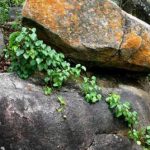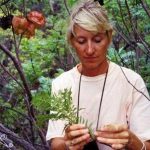TREE LIFE
APRIL & MAY 1992
MASHONALAND CALENDAR
Tuesday 5th May : Botanic Garden Walk. Although traditionally May is the “switch to Saturday for winter” month we’ll keep to Tuesday this time because of the long weekend, Friday 1st being a public holiday. So park at the Herbarium where we will meet Tom Muller at 5 pm.
Monday 11th May : We are fortunate indeed to get another opportunity to see Mr Lyn Mullin’s magnificent slides on Trees of historic interest, of medicinal or rarity value, or of unusual size. The History Society is hosting this show at the Beit Hall, Prince Edward School at 5.50 for 5.45 pm, and have extended an invitation to anyone who’d like to attend. There will be a silver collection in aid of the Prince Edward Rugby Tour, whose members will provide us with tea.
Sunday 17th May : This month our hosts are Mr and Mrs Jack Taylor of Vureneme Farm at Muswewenhede, formally Msonedi. (It’s not only the botanic fraternity who delight in changing names). The Taylors have built a magnificent dam which, in its four year life, has spilt every year but this. There is interesting riverine vegetation, a huge granite dome offering a superb 360° view and some woodland something for everyone. ‘
Saturday 23rd May : Walk with Mark in Mukuvisi Woodlands, meet in the main car park at 1500 hours.
Saurday 6th June : Botanic Garden Wall
MATABELELAND CALENDAR
Weekend 30th ‘april to 3rd May 1992 : – this trip has been over subscribed and booking closed! but for those that are coming for the whole time or just a day:
Wednesday 13th May: Ian will be back to take us on the usual McHEW at Hillside Dam at 1700 hours.
Sunday 7th June : We had such a welcome last time at Mike and Trish Wood’s Glehcurregh Farm, 75 km out on (and beyond) Nyamandhlovu Road, that we have been looking forward to a repeat – but this time on the north—east end of the farm. All day, meet at the Blake‘s home at 8.30 am to sort out transport or at the Falls Road Motors at 8.45 am. Sesamothamnus lugardi here we come I Bring tea time/lunch/chairs .
Wednesday 17th June : McHEW at Hillside Dams at 5 pm
The 42nd A.G.M. of the Society was held on Sunday 12th April. The Chairman‘s Report and Fiona’s account of the day follow :
One of the most important principles in the Tree Society is that of ‘no guilt‘. The classic guilt ridden introduction is : “I’m sorry I missed the past two outings, but you see . . .”. No, I don’t see, I don’t see why you should apologise , the fact “that you are here now means that you want to be here and that you do do enjoy whatever the society provides for you. The fact that you were not here last time proves that you are a busy person with many interests, and that is a wonderful state to be in — so why feel guilty?
So the message is : we are glad to see you whenever we do. If other things take priority on occasions, then that’s fine, don’t feel guilty living life to the full. We also have many dormant members who pay their subs, whom we have never seen – that’s wonderful, their continued financial support allows the society to continue functioning.
This will be my last outing with the society for a while but endings and beginnings merge together and I have seen enough changes to know that none us is indispensable. I remember thinking “And now what” when Doug and Lola left. The same was true when Paul died, or when Meg left for Fothergill, when the Reids went to Marondera, when Dick died so suddenly, and when Gill decided that Chegutu was her last active outing. But surprisingly the Society survived all of these occasions. Things changed. The character of the Society changed, out the tribute to all of these people is that the Society they had taken so much pleasure in continued. My life has changed in a single year, and promises to change even further in the next. I am not any less busy now than I was 8 years ago when Phil and I would do the recess, take the outings write the newsletters, take it to the typists, collect it, collate it and mail it. But now my life is filled with different things and other responsibilities. In essence the society has been running happily with very Little input from me for the past -5 months, so I can assure you that the Society is in most capable hands .
The Society is glued together by the trees around us, but it is important too that we all bond as people. We are all actually very fond of each other, even those with whom we have had our differences in the past. We have shared our lives with each other, and that is the most important thing we have. In the long run it is people that count most in life and I thank you all for the many times and characters that belong to the society. Pam who taught us to hold onto our dangly bits while climbing through barbed wire fences; Meg who stalks trees with such an ardent stride; to who ever invented hockey sticks and dead branches on the left hand side of Pericopsis; Hughie Taylor for his Petrocarpus nglo’ensis; Ian Milton who ‘did’ the first hole by disappearing suddenly into an ant bear excavation in the shade of a spectacular Zanha golungensis; Benedicta whose excitement overflows the pages on which she writes and runs up both margins; Marjorie who failed to complain when she shared her bed with the mice of Gona-rhe-zhou; Ken Blake’s jolly smile; the ladies at Duplicating Services who offered me tea as literally I dripped sweat over the copy that I was trying to correct; Gill whose memory focuses in on specimens from Buhera from a different era; Phil and Cherry who have never lived down their mouldy wedding cake; and Ilene Mcbean for changing out of wet soggy clothes into the seven veils that danced so blithly across a kitchen floor.
But besides looking backwards, the Society is at present in an unobtrusively productive phase. In her own modest way Maureen has been organizing tree labelling exercises that have proved most rewarding. At Outward Bound in the Chimanimanis the labels made for the scholars are attracting the attention of adults as well. And as for experiments on labels – Maureen and Fiona have tried out all sorts of pens, plastics and cattle ear tags to find a cheap system that works. The unspoken secret is that Maureen has been backbone of the Society since Dick died, we are indeed indebted to her. Another unobtrusive but massive undertaking has been the tree-mapping exercise which Fiona has put many hours into. This ongoing project consolidates much of the information that has till now been lost in the archives of the Tree Society records.
The past year’s outings have offered an interesting variety, going to new places and revisiting old favourites: the spectacular whalebacks of Ngomokurira (June), the woodland of Kyle Farm, Mutorashanga (July) , Rocky Mountain Farm which still hides its secret Commiphora ugogensis (August) , Outward Bound which is the first time that the Chimanimani has not intailed climbing Bailey’s Folley (August), return to Stanley Farm in Chegutu, the home of Haplocoelum (September), the famous Ochna gambleoides of Thetford (October), the arboretum at Lake Chivero where we still need to check on the missing Milicia (0ctober), the Simleit’s farm with ox wagons and wine for lunch (November) , the Ewanrigg social (December), the hot climb and hunt for missing children at Tsindi Ruins, or is it the Great Tsindi as the TV announcer stated – no-one would go to visit ruins! (January), then at last, after 11 years, the visit to the big tree at Chirinda. forest, Mt Selinda. (January), a revisit to New Erewhon and Binga Swamp Forest (February) the visit to Meg’s new haunt on SS Ranch (March) where Cheryl did her hole while admiring the magnificent Ficus sycomorus the day Nkomo Barracks blew up in 1981. For all these outings we thank our many hosts and the many contributors who have penned our record in Tree Life; Benedicta Graves, George Hall, Fran Mutapiwho has proved to be a most valuable scribe on Botanic Garden walks and Ken Blake who keeps us informed of the enthusiasm in Bulawayo. Ken has also been very generous in providing paper for Tree Life and for printing cards at less than cost. This is most important in keeping our subscriptions to a minimum, but any extra donations are always gratefully accepted, as are any contributions for Tree Life, either original or not.
So I see the Society at a sure position right now, a stable foundation, an excellent track record and a promising future. The only note of major concern is the uncertainty that surrounds the greatest pillar of the Society. A pillar that has served us all well and to whom we are all totally indebted. I refer most naturally to Tom who is due to retire later this year. We must confess that much of our enthusiasm emanates from him. We have all benefitted greatly from standing in his shadow. In the same breath, but in a completely different way, we also acknowledge our debt to Bob who can tease and infuriate but who has one of the biggest hearts I know. Where would we be if we had not had these two stalwarts in our midst.
-Kim Damstra
A.G.M. SERUI SOURCE, NORTON, 12TH April, 1992.
After greetings and a bountiful tea the 42nd Annual General Meeting of the Tree Society was held in the front of Jim and Ann Sinclair’s lovely thatched home in the dappled shade of two enormous trees. There were approximately 65 of us present – some measure of the affection members have for our outgoing chairman, for this was, AGM apart, our opportunity to say “au revoir” to Kim and Cecile before their departure for Norway.
In his report Kim looked back over his years with the Tree Society, fondly recalling past events and people who are no longer with us, and consoled us with the thought that no one is indispensable, that in the end the tree remain the constant that bind us loosely together. Indeed, commonsense and experience tell us so, but can the bush ever be quite so much fun again with sound scientific knowledge imparted in his inimitably enthusiastic and irreverent fashion – sensuous mermaids, musty wedding cakes and all. I think, for a while at least, tree life and Tree Life is going to be somewhat duller for his absence.

Afzelia quanzensis. Photo: Rawdon Goodier. Source: Flora of Zimbabwe
Business finished, it was off to some leisurely treeing in very hot sun not far from the house, admiring on the way the autumn gold of Lannea discolour (not datcolour). There is little virtue in giving a list for the day (Maureen had 75 ticks on the card), but I will mention some of the trees that spring to mind. The first of these was Afzelia quanzensis (Pod Mahogany), no pods, but with characteristics of translucent yellow borders to the wavy edged leaflets and the twisted petiolules. Moving on we encountered our usual either/or’s : Vangueria infausta/Vangueriopsis lanciflora – our monthly teaser, but really it would not be Tree Society without it, would it? I think we profess puzzlement to keep up the tradition and hear someone say, once more, the aid memoire “Vangueria is hairia”.
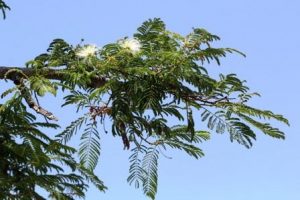
Albizia harveyi. Photo: Bart Wursten. Source: Flora of Zimbabwe
Albizia harvey/A.amara – with their fine leaflets that can be a problem when growing together at the same altitude. A. amara is normally the high altitude species and it was our tree today lacking the sickle shaped leaflets and sharp spines of hardened leaf scars which can be present in A.harveyi. In an earlier Botanical Garden Walk write up Kim said that Tom had suggested that the position of the gland on the petiole might aid identification. In the gardens that of A.amara appears on the lower half of the petiole, A.harveyi’s on the top half. We did not check.
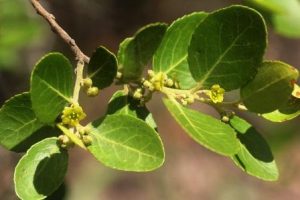
Cassine aethianica. Photo: Bart Wursten. Source: Flora of Zimbabwe
Cassine aethianica/C.matabeleensis – I find the CELASTACEAE family a difficult one, with identificationnot only between species difficult, but between genera too, for example between Cassine, Maytenus and Catha. Anyway our sample tree on a termite mound was Cassine aethiopica with almost round leaves in spiral formation. Going through back numbers of Tree Life I found that Phil said it looked like Maytenus undata. Cassine matabelensis, he says looks more like Catha edulis and anyway its leaves are alternate with some opposite to sub-opposite on the same shoot. We came across Cassine transvaalensis after lunch on yet another termite mound and noted its very much narrower, serrated leves. By the way there is so much information (field derived) in Tree Life that it is always makes a good, informative read and greatly supplements Coates Palgrave.
Clerodendrum glabrum/C.wildii not really a problem. Both were here, allowing us a comparison. C.glabrum leaves were not at all glabrous, butvelvety and in whorls of 3 with the characteristic unpleasant smell and G.wildii purple-petioled and with a much stronger smell. (Still on smells, Maureen pointed out that crushed Pavetta gardenifolia leaves are unpleasant too, while those of Pavetta shumanniana, growing nearby, were not.)
Diospyros lyciodes?Euclea divinorum – no, no difficulty in telling them apart, we were just reminded by Kim of their efficacy as toothbrushes and their different after effects — a vampire like red mouth with Diospyros, a yellow one with Euclea.
By now heat, inner rumblings and thirst made themselves felt and brought us back to the shade in front of the house where we settled to our various lunches accompanied by chilled white wine. George gave a speech of appreciation and thanks to Kim, and Jessica and Jemima presented him with bound copies of Tree Life – green bound from Harare and red from Bulawayo. Parcelled up they looked very box-like, causing Joan Condy to exclaim ”shoes at lastl”.
The afternoon session started with a quick trip by truck to visit a Ficus sycomorus quite close by. It was remembered in the Tree Society at least, because Cheryl fell down a hole while admiring it on a previous occasion. I missed this jaunt, so can add nothing further. Our second afternoon trip, again in trucks/cars, took us to some woodland a little way on, near the dam where among others, we identified Gardenia ternifolia, tongue testing it to feel the rough hairs on both leaf surfaces. There were orange fruited Duranta repens in great numbers, also Flueggia virosa on the termite mounds. Trichalysia niamniamensis (ex T.angolensis_was there and I wish I had already read again in a back Tree Life) that its flower buds are almost always present, usually in groups of 3 so that I could have checked – next time.
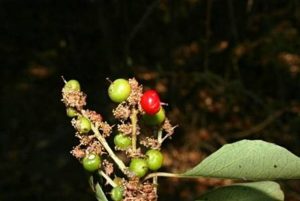
Scolopia zeyheri. Photo: Mark Hyde. Source: Flora of Zimbabwe
Undoubtedly, the major find of the day was the thorn pear Scolopia zeyheri of the FLACOURTACEAE family, formidable spines on trunk and branches and with dark green upper surfaces to the leaves which, when bent, showed a line of whitened wax cuticle. We don’t often see this tree, nor Dick Petheram’s Brachylaena rotundata showing the very typical grey/white under surface hairs of the ASTERACEAE family.
After a ride back to the house we ended with tea and the remainder of the cakes from the morning. A satisfying day and one in which, for me anyway, the trees took second place, for my memories will be of people, young and old — baby Theo lying blissfully asleep along his father’s arm, Kenneth force feeding a grasshopper grass, Dick and Edone Petheram still finding something new to learn about the trees; and, my goodness the hats — the most extraordinary variety, from Vida’s natty topee, through Japanese soldier (Cheryl), battered bush (Ken Davey) to Ann Bianchi’s enormous straw with its Carissa edulis plume.
It remains only to say thank you to all who brought cakes and savouries for tea, to the committee members for the wine, but most especially to our hosts, Jim and Ann for their hospitality and for allowing us to enjoy their beautiful home and garden and, of course, their trees.
To him we say thank you; it’s been fun. To him, Cécile and Theo, GO WELL
-George Hall
Your Committee for the next year is :
George Hall – Vice Chairman; Joy Killian – Treasurer; Maureen Silva Jones – Secretary; Tessa Ball
Fiona Dawe; Andy MacNaughtan; Bob Manser; Vida Siebert
If anyone knows of a suitable venue or of one which may be suitable or if there is a particular spot which you would particularly like to visit for either a normal Sunday field trip or a longer field trip or a longer weekend ‘extra’ please contact a committee member and a recce will be carried out and hopefully a trip planned.
APRIL MCHEW
As Ian and Margaret were away at Sentinel Ranch (between Beit Bridge and Tuli) with the Falcon College expedition (wait for their reports!) I decided to take “the mob” to Mabukuwene Nature Garden for our outing. Usually we have limited the talk to 5 species, but with so many to choose from, I got carried-away and the photocopies were of Pseudolachnostylis maprouneifolia, Croton gratissimus (both EUPHORBIACEAE) and Securidaca longepedunculata, very approachable half way up the stone steps, and at the top, good specimens of Schrebera alata, Pappea capensis (Thora’s tree), two unusual Zanthoxylum capense, one mainly with the terminal leaflets in place, the other without, as in CP which states that the terminal often aborts –and from inside the summer house a gorgeous view down onto a green and gold and fruiting Pterocarpus angolensis. Nonie was in her element calling out the National numbers.
With all the members being sated with information and the almost full moon up it is surprising we did not stay in the elevated summer house all night. Betty and I learnt a lot, designing the outing and it seemed to be appreciated all round. Thank you all for coming. Ken Blake.
MATABELELAND NOTES
The idea of a “secret” valley in the Matopos attracted quite a few members on Sunday, 5th April. A large Afzelia quanzensis greeted us at the turn off and we parked under a giant Sclerocarya birrea with many green marulas underfoot. There was a breeze and it was slightly overcast, so we were not bothered by mopane flies. We followed a track flanked by Ficus ingens and Ficus glumosa, Cassine matabelica, Croton gratissimus, Pterocarpus angolensis and P.rontundifolius (st ill crowned with yellow flowers) and then climbed down into the valley amongst Heteropyxis debniae, Strychnos cuccoloides, S. madagacariensis, S. spinosa and Erythrococca trichogyne (no twin berries around). Several hundred brown ticks hitched a lift on our clothes at one point but we despatched them rapidly. The Euclea natalensis were much taller than the ones we usually see, as was an Ochna pulchra looking very like a mermaid. After we had found Ficus sur and F.glumosa near a dry stream bed and watched a klipspringer we decided to leave the Barleria albostellata which was almost impenetrable and making us sneeze and we made our way back to the base of the rocks which were covered with Strychnos matopensis and Pterolobium stellatum. The centre of the valley large Burkea africana, Cassia abbreviata (tracked down from a pod on the ground), Combretum apiculatum, Lannea discolour, Terminalia sericea, T. trichopoda, Pavetta eylesii (the bark hanging in shreds), Peltophorum africanum and Olea europea subs. africana which was of interest to our new French members, the Vanots who know the European olive and say the leaves there are smaller, but the fruit much bigger.
On our way back for tea we found what looked a bit like Maytenus heterophylla, but when we traced the smooth silver grey bark upwards we found it was part of a 10m high Securidaca longipedunculata and full of winged seeds. Over on the dwala were Albizia tanganyicensis, Commiphora marlothii, Kirkia acuminate, Ptaeroxylon obliquum, large patches of tall Elephantorrhiza goetzei; a small Turraea obtusifolia was in flower and fruit and we were able to compare its leaves with those of the longer droop tipped T.fischeri. Near the top of the kopje were Acokanthera ratundata, Homalium dentatum (for once we were able to examine the toothed leaves which are usually almost out of sight), Ficus natalensis and a stunted Cordia grandicalyx.
We had a leisurely lunch and then nine of us walked up to Rhodes’ grave from the Lower Outspan. Geoff gave a very interesting talk on the way Rhodes’ body was transported to his final resting place just 90 years ago. Different trees lined our route on the opposite side of the Circular Drive – Faurea saligna, Parinari curatellifolia, Pittosporum viridiflorum, Euphorbia cooperi and n enormous Artabotrys brachypetalus which was wound round itself, its original support no longer in evidence. A total of 89 species were identified. Betty Blake.
NYARUPINDA CATCEHMENT APRIL/MAY 1992
S.S. Ranch Quiz : If you did not do too well in the Quiz do not despair, you have learnt that it is possible to identify species from scraps of information and also which characters are important for identifying species. Incidentally the “Taber Encylopaedia Zimbabwe” is a useful references for all sorts of things including Natural History; Thank you Maureen S J for suggesting the spider with a white zigzag area in its web was a Golden Orb spider. The
0rbweaver’s web in Brachystegia wood land at Tinto was destroyer} by falling branches, the spider deserted the funnel where she lived. No specimens of male or female spider have been found to send to Mrs Minshull at the Natural History Museum in Bulawayo. The tiny coral pink spiders (Tree Life 143) had several misadventures in their Diospyros kirkii leaf they blew away to the herbs near the kitchen. Their size is the same, they were not spiderlings but adults.
The scene : Observations of this seasons semi—arid environment concerns nature’s response to the drought, common place becomes unusual and vice versa.
A schematic diagram of the interactions of climate and soil, water and food, stress on terrestrial living things looks like a ‘spaghetti junction‘; all the comings and goings leading to loss of vigour and diminished growth which affects their structure and function now and in years to come.
HERE ARE SOME OBSERVATIONS ABOUT THE DROUGHT
1.Where there is less shade, there is more grass e.g:. Uapaca kirkiana leaves are smaller than usual so that there is more light beneath them to enable grasses to become established.
2.Leaf and plant litter has not decomposed, to add its bulk to the soil, it will burn or blow away unless termites rescue it.
3.Many forbs (i e all vegetation other than trees, shrubs and grasses) have failed, to flower, they are withering away. It has been a poor season for ground Orchids, flame lilies and many other plants which have under ground storage structures; geophyllus plants where known to occur: have not emerged, eg Nervilia orchid. One Ceropegia, a yellow one, has come to light, some months later than usual .
4.Heavy crops of fruit on indigenous trees and shrubs weigh down the branches. The rain tree Lonchocarpus capassa is a memorable sight. Either natural periodicity or the climate has prevented the round leaved mukwa Pterocarpus subsp. Polyanthus v. martanii from blooming between late December and January when it usually produces masses of yellow flowers.
5.April 12th premature leaf fall noticed in the following species.: Cussonia arborea, Julbernardia globiflora, Lannea discolour, Sterculia quinqualoba, Zanha africana and some limbs of the msasa trees, Brachystegia spiciformis. Leaves of duiker berry tree have become party orange and red as in autumn and winter, it points to the fact that water stress rather than lower temperatures cause the winter colour of Pseudolachnostylis maprouneifolia.
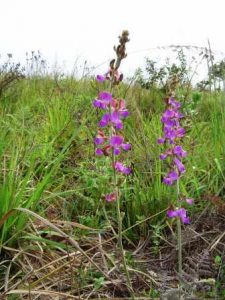
Doliches kilimand-scharicus. Photo: Bart Wursten. Source: Flora of Zimbabwe
6.Birds’ nests are easier to find because foliage is not as thick as usual. This is quite exciting for novice ‘birders’ but encourages predators, for some weeks a Gyamogene has frequented the environs of Tinto . Ground-sited nests are usually well disguised, we have noticed two recently, one safe against a robust clump of a grass screen fence, another was vulnerable under a wild lupin on open ground. With a bit of practice the Latin name of this plant trips off the tongue, Doliches kilimand-scharicus its red woody root stock is a familiar sight on newly ploughed lands.
7 Search for food and shelter may have made woodland dormice come into the house and outbuildings as never before. They are appealing with their gentle eyes, round ears and bushy tails. We are looking for a. trap which does not kill, so as to relocate them. It is centipede-in-the-house season, they follow a scent path to the T.V. set.
8 If we knew about dendroclimotology and could project ourselves into the future, we would have noticed that narrow growth rings in timber were formed this season, many trees would have been sampled radially with a borer which removed cores of wood a few millimetres in diameter, this did not harm the trees. If lower temperatures had prevailed and there had been good old fashioned wet season the trees would have increased in girth by virtue of their wider growth rings.
FURTHER READING
It is hoped that you enjoyed the further reading mentioned in last months’ Tree Life, photocopies are worth making for friends who have not had the opportunity of seeing this excellent paper on termites. In preparation for next month’s contribution from me you could prepare yourselves for it by looking at the ‘Agro-Ecological Survey” published by Government Printers — years ago. This publication has a set of maps in the folder attached to the back of the book.
That is all for this month. The writer intends to learn to recognise and identify a, few common grasses so to be able to mention the vegetation in vleis or dambos in her next contribution to Tree Life.
-Benedicta Graves
KIM DAMSTRA CHAIRMAN
r


